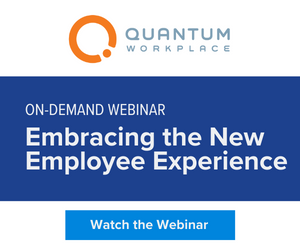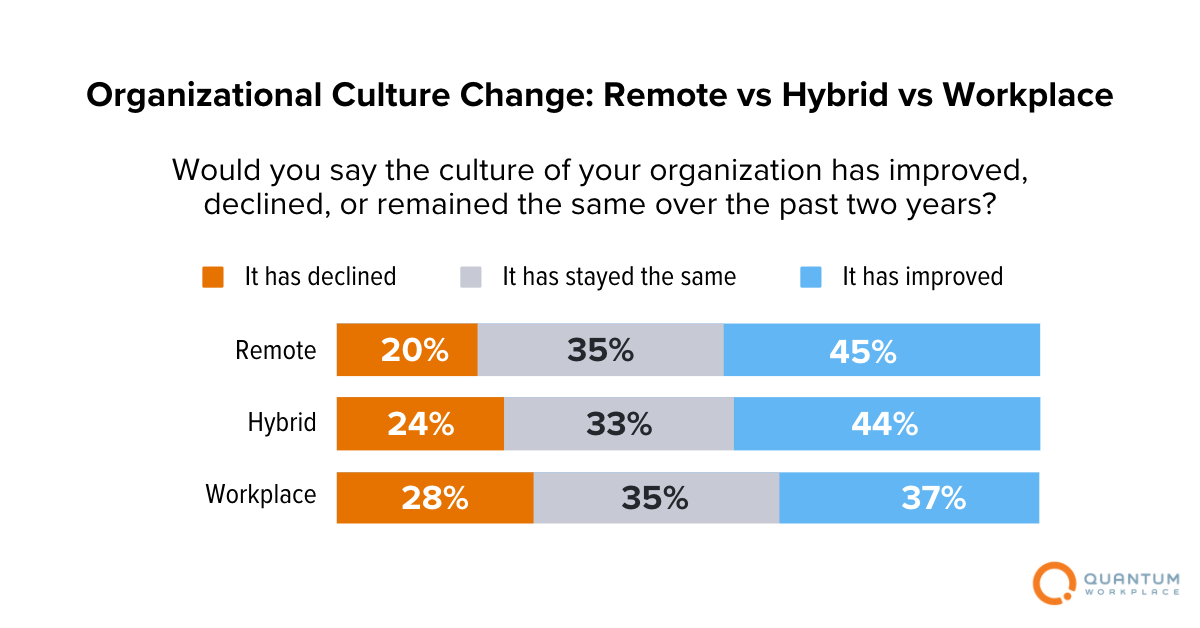There’s a push and pull going on between leadership and employees. Leadership is pulling back to the management philosophies they’re comfortable with and have seen success by requesting employees come back to the office. Employees are pushing for an easier integration of work life and personal life. Quantum Workplace research shows 65% of employees say their company culture has changed in the past two years.
As organizations work to determine the “new normal,” leaders need to make sure they have a handle on workplace culture. Being intentional with culture connects employees to the organization and boosts engagement.
What is workplace culture?
The struggle for many leaders has been defining what culture is. Culture consists of many different elements of the work experience, from how decisions are made and how the organization communicates and behaves, to how work is celebrated.
Understanding how employees experience workplace culture is helpful in creating a culture workers want to be a part of. The top three aspects where employees experience culture the strongest are:
- Mission and values statement
- Recognition and celebrations
- Approach to employee performance
Why has culture changed?
Easy. The workplace has changed. What worked for your workplace before the pandemic probably won’t work today. That includes your culture, which must evolve to the new realities, preferences, and behaviors in today’s workplace. A Quantum Workplace survey shows the structure of teams looks different now, with more remote and hybrid structures. Of those surveyed:
- 44% work with hybrid teams
- 36% work with remote teams
- 20% work with onsite teams
In the same survey, hybrid teams reported higher levels of engagement, followed by remote teams. Onsite teams reported engagement levels around 10% lower than hybrid teams.
Workplace culture has changed—and those changes have impacted employees differently. Remote and hybrid employees are more likely to say that workplace culture has improved, while workplace employees are slightly more likely to say their workplace culture has declined.
 What are employees looking for?
What are employees looking for?
Quantum Workplace research shows employees use the following words to describe an ideal workplace culture:
- Flexible
- Inclusive
- Supportive
- Collaborative
- Caring
The workplace was already shifting to be more flexible, inclusive, supportive, collaborative, and caring. The pandemic put that shift into hyperdrive. An extremely competitive job market has increased the power talent has in influencing organizational changes. Employees want to actively play a role in the organization, contribute ideas that better the organization, and be recognized for their work.
As organizations transition to a different way of getting work done, they’ll need to have a pulse on what is happening deep within the organization. This will help leaders understand exactly what employees want and what changes will help make the culture more engaging.
How do we bridge the gap?
Finding an employee listening technology partner can help you:
- Identify what is going on deep inside your organization
- Uncover obstacles and opportunities
- Connect the dots to other metrics like turnover and engagement
- Take appropriate action in shaping your workplace culture
- Create a great employee experience
Organizations will need to update their dated view on workplace culture and aim their strategies toward engaging employees to create a magnetic culture for retention and recruiting and to meet business goals. Think about what your culture is versus what you want it to be.
Here’s a successful strategy to get your started:
- Ask – Gut instincts are not a good measure of culture. To measure culture, you need to ask your employees about their experiences. Your employees will tell you their thoughts and what they need. Gathering employee feedback will let you know what’s working and what’s not. Creating a culture of feedback where it’s not only requested, but also expected, leads to more transparency and communication throughout the organization.
Developing an employee listening strategy will help you take the reins on culture in your organization. Gather feedback at different points in the employee journey like following onboarding, after a significant change, or when an employee exits the organization. This provides insights into what might be hurting your organization’s culture and how you can better the employee experience and in turn, create an engaging work culture.
- Analyze – Feedback shouldn’t be analyzed in a silo. It should help you visualize exactly what is going on in your organization. Take the feedback and connect it to other metrics like turnover and number of performance conversations. Create an employee engagement dashboard to see if your engagement strategy is working. Have your fingers on the pulse of turnover by calculating your turnover rate and learning why people are leaving the organization. Use your people analytics to discover if employees are meeting expectations, if managers are effective, or if you need to develop a plan to address skill gaps.
Determine what’s linked and prioritize what needs to be fixed by aligning with business objectives. Figure out what an engaging culture should look like at your organization and what changes are needed to get there. Then create a strategy to remove barriers to achieving your business goals and aim your culture at engagement.
- Act – It’s not enough to just ask. Show employees you care by making meaningful changes that better the employee experience and help everyone reach their goals. When employees see success, the business sees success. Since employees experience culture strongly through mission and values, recognition, and performance, take the first steps in shaping your culture by honing in on those experiences.
Increase communication connected to your mission and values. Ensure this communication is frequent and clear. Recognize behaviors connected to the organization’s values and create channels for employee-to-employee recognition. Show employees their work is appreciated by recognizing the work that went into a project and connecting it to the organization’s goals. Align employee goals with the organization’s so employees can see how they contribute to the organization’s success. And encourage managers to have frequent feedback conversations with their employees that builds on the culture of feedback you create with a listening strategy.
If organizational culture is how work gets done, being intentional about creating it is the way to meet your business goals. Relying on culture of the past might not get you there. The workplace has changed a lot in the last couple of years, and workplace culture with it. Future success in engaging, retaining, and recruiting talent will be determined by the culture you create.
The post Creating Culture: The Critical Role of Employee Listening appeared first on HR Executive.
